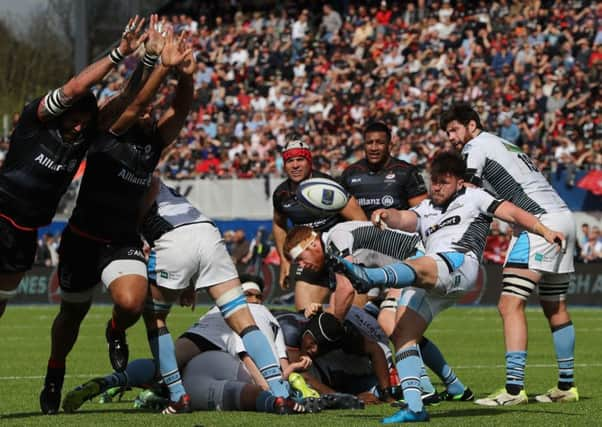Allan Massie: Well-judged kick can be best attacking option


In League, there is often more variety in attack in what is called the Red Zone. This is essential because the five-tackle rule means that a League side has time-limited possession. It can’t keep hammering away in the hope that eventually a defender will make a mistake, step out of the defensive line or miss a tackle. You can’t go through a dozen or more phases as you can in Union. So you have to be clever. Often this means delivering a clever kick – chip, grubber or diagonal.
Union players use these kicks, too, but are often shy of doing so. Nobody is going to blame you if you choose to run into a tackler and make the ball available to your scrum-half again. But a kick that doesn’t yield a try is seen as a missed opportunity, an error either of judgment or execution. So, more and more, a Union player will kick in the opposition 22 only when his side have a penalty advantage. Then if it goes wrong and no try is scored, the commentator will say “it was a kick to nothing; they still have the penalty”. Preferring yet another pick-and-go or pop pass to a powerful forward rather than an attacking kick is a sign of timidity.
Advertisement
Hide AdAdvertisement
Hide AdYet the well-judged kick is an easier way of scoring a try than repeated frontal assaults, blitzkrieg rather than poor bloody infantry slogging. Two recent examples make the point. Last Sunday, Finn Russell’s diagonal was so well placed that Lee Jones was able to take it without breaking stride, step inside the first defender, hand-off Chris Ashton and gallop over the try-line. Perfect. A fortnight previously against Italy, Ali Price delivered a beautiful kick from the base of a ruck (with his weaker right foot, incidentally) which enabled Stuart Hogg to leap and pat the ball back for Matt Scott to fall on and score the try. We had a penalty advantage in this case – I can’t remember if Glasgow had one when Finn chose to kick. But, in a sense, this doesn’t matter. The tries would both have been scored whether an advantage was being enjoyed or not. But, in the case of Scott’s try, one wonders if Ali Price would have attempted that kick if advantage wasn’t being played. And yet – advantage or not – it was the right thing to do.
The All Blacks score more tries than anyone else from attacking kicks, often grubbers. They do so because they recognise that it is often easier to score by putting the ball behind the defence or into the arms of a wing with a diagonal (sometimes now called a kick-pass) than trying to force their way through a committed and well-organised defence. So they score lots of what one may call League-style tries.
Yet in Union players may not dare to kick till they have the security blanket of a penalty advantage. They prefer to play safe and retain possession. It’s understandable. You have worked hard to get in an attacking position and so you may be reluctant to risk losing it if your kick goes wrong. Yet, at some point, unless you score, you lose possession anyway. How often, after all, does one see repeated attempts to break through end with a knock-on or the ball-carrier becoming isolated and stripped of the ball. The apparently safe option – just keep possession – is not always the best one.
One might add a footnote. Referees now play very long advantage, too long, one often thinks. At times they seem to think it impossible for a side to lose its advantage. The law used to be interpreted differently. If, for instance, the side enjoying an advantage made a mistake, a knock-on or forward pass, advantage would have been judged to be lost and the opposition would be given the put-in at the scrum. Now referees are more likely to go back to the original offence which created the advantage. This often seems unfair. There is, however, one thing to be said for the generous interpretation of advantage. It seems to have eradicated a deplorable practice which crept into the game a few years ago, whereby a player on the side with a penalty advantage would deliberately drop the ball. But this could have been easily corrected. The referee could simply have said “advantage lost” and given the scrum to the other side.